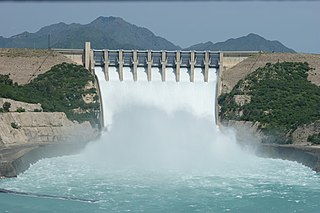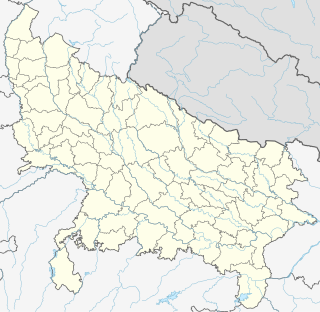
The Kariba Dam is a double curvature concrete arch dam in the Kariba Gorge of the Zambezi river basin between Zambia and Zimbabwe. The dam stands 128 metres (420 ft) tall and 579 metres (1,900 ft) long. The dam forms Lake Kariba which extends for 280 kilometres (170 mi) and holds 185 cubic kilometres (150,000,000 acre⋅ft) of water.

The Itaipu Dam is a hydroelectric dam on the Paraná River located on the border between Brazil and Paraguay. The construction of the dam was first contested by Argentina, but the negotiations and resolution of the dispute ended up setting the basis for Argentine–Brazilian integration later on.

Lake Minnewanka is a glacial lake located in the eastern area of Banff National Park in Canada, about five kilometres northeast of the Banff townsite. The lake is 21 km (13 mi) long and 142 m (466 ft) deep, making it the 2nd longest lake in the mountain parks of the Canadian Rockies.

The Mangla Dam is a multipurpose dam located on the Jhelum River in the Mirpur District of Azad Kashmir in Pakistan. It is the seventh largest dam in the world. The dam got its name from the village of Mangla. Major Nasrullah Khan of the Pakistan Army revealed for the first time in 2003, that the project was designed and supervised by Binnie & Partners of London, and it was built by Mangla Dam Contractors, a consortium of 8 U.S. construction firms, sponsored by Guy F. Atkinson Company of South San Francisco.

The Tehri Dam is the highest dam in India and one of the highest in the world. It is a multi-purpose rock and earth-fill embankment dam on the Bhagirathi River near Tehri in Uttarakhand, India. It is the primary dam of the THDC India Ltd. and the Tehri hydroelectric complex. Phase 1 was completed in 2006. The Tehri Dam withholds a reservoir for irrigation, municipal water supply and the generation of 1,000 megawatts (1,300,000 hp) of hydroelectricity. The dam's 1,000 MW variable-speed pumped-storage scheme is currently under construction with expected commissioning in May 2018.
Development-induced displacement and resettlement (DIDR) occurs when people are forced to leave their homes and/or land as a result of development. This subset of forced migration has been historically associated with the construction of dams for hydroelectric power and irrigation but is also the result of various development projects such as mining, agriculture, the creation of military installations, airports, industrial plants, weapon testing grounds, railways, road developments, urbanization, conservation projects, and forestry. Development-induced displacement is a social problem affecting multiple levels of human organization, from tribal and village communities to well-developed urban areas. Development is widely viewed as an inevitable step towards modernization and economic growth in developing countries; however, for those who are displaced, the end result is most often loss of livelihood and impoverishment.

The Merowe Dam, also known as Merowe High Dam, Merowe Multi-Purpose Hydro Project or Hamdab Dam, is a large dam near Merowe Town in northern Sudan, about 350 kilometres (220 mi) north of the capital Khartoum. Its dimensions make it the largest contemporary hydropower project in Africa. It is situated on the river Nile, close to and inundating the 4th Cataract where the river divides into multiple smaller branches with large islands in between. Merowe is a city about 40 kilometres (25 mi) downstream from the construction site at Hamdab. The main purpose for building the dam was the generation of electricity.

The Nurek Dam is an earth-fill embankment dam on the Vakhsh River in Tajikistan. Its primary purpose is hydroelectric power generation and its power station has an installed capacity of 3,015 MW. Construction of the dam began in 1961 and the power station's first generator was commissioned in 1972. The last generator was commissioned in 1979 and the entire project was completed in 1980 when Tajikistan was still a republic within the Soviet Union, becoming the tallest dam in the world at the time. At 300 m (984 ft), it is currently the second tallest man-made dam in the world, after being surpassed by Jinping-I Dam in 2013. The Rogun Dam, also along the Vakhsh in Tajikistan, may exceed it in size when completed.

Tarbela Dam is an earth-filled dam on the Indus River in Khyber Pakhtunkhwa, Pakistan. It is the largest earth-filled dam in the world, and also the largest dam by structural volume. Located in the Swabi and Haripur Districts of Khyber Pakhtunkhwa, the dam is about 30 km (20 mi) from the city of Swabi, 105 km (65 mi) northwest of Islamabad, and 125 km (80 mi) east of Peshawar.

The Birecik Dam, one of the 21 dams of the Southeastern Anatolia Project of Turkey, is located on the Euphrates River 60 km (37 mi) downstream of Atatürk Dam and 8 km (5.0 mi) upstream of Birecik town 80 km (50 mi) west of Province of Şanlıurfa in the southeastern region of Turkey. It was purposed for irrigation and energy production. There is a run-of-the-river hydroelectric power plant, established in 2001, at the dam, with a power output of 672MW can generate an average of 2.5 billion kWh per year. The Birecik dam is a structure consisting of a concrete gravity and clay core sandgravel fill with a height of 62.5 m (205 ft) from the foundation. It was designed by Coyne et Bellier. The total catchment area is 92,700 ha (358 sq mi). The Birecik project will be realized under the status of Build-Operate-Transfer (BOT) model.

The Karakaya Dam is one of the 21 dams of the Southeastern Anatolia Project of Turkey, built on the Euphrates River and completed in 1987. The hydroelectric dam generates power with six units of 300 MW, totalling the installed capacity to 1,800 MW.

The Keban Dam is a hydroelectric dam on the Euphrates, located in the Elazığ Province of Turkey. The dam was the first and uppermost of several large-scale dams to be built on the Euphrates by Turkey. Although the Keban Dam was not originally constructed as a part of the Southeastern Anatolia Project (GAP), it is now a fully integrated component of the project, which aims to stimulate economic development in Southeastern Turkey. Construction of the dam commenced in 1966 and was completed in 1974. Keban Dam Lake, the reservoir created by Keban Dam, has a surface area of 675 square kilometres (261 sq mi) and is reputedly the fourth-largest lake in Turkey after Lake Van, Lake Tuz, and the reservoir created by the Atatürk Dam.

Rihand Dam, also known as Govind Ballabh Pant Sagar, is the largest dam of India by volume. The reservoir of Rihand Dam is called Govind Ballabh Pant Sagar and is India's largest artificial lake. Rihand Dam is a concrete gravity dam located at Pipri in Sonbhadra District in Uttar Pradesh, India. Its reservoir area is on the border of Madhya Pradesh and Uttar Pradesh. It is located on the Rihand River, a tributary of the Son River. The catchment area of this dam extends over Uttar Pradesh, Madhya Pradesh & Chhattisgarh whereas it supplies irrigation water in Bihar located downstream of the river.

Aslantaş Dam is an embankment dam on Ceyhan River in Osmaniye Province, southern Turkey, built between 1975 and 1984.

The Kiri Dam is in Shelleng local government area of Adamawa State in the north east of Nigeria, damming the Gongola River. It is a 1.2 km long, 20 m high zoned embankment with an internal clay blanket.The dam was mainly completed in 1982. The reservoir has a capacity of 615 million m³.

Sơn La Dam is a concrete gravity dam on the Black River in Ít Ong, Mường La District, Sơn La Province, Vietnam. It is the largest hydroelectric power station in Southeast Asia.

The Sirindhorn Dam is located in Sirindhorn District, Ubon Ratchatani, Thailand. It impounds the Lam Dom Noi River, and its reservoir is the province's largest water resource. The dam was commissioned in 1971 to serve as a hydropower facility as well as to supply irrigation water. The dam was named after Princess Royal Sirindhorn. All of the electricity generated by the dam is destined for domestic markets. The dam was constructed and is owned and operated by the Electricity Generating Authority of Thailand and is located in the Mekong River Basin, just upstream from the controversial Pak Mun Dam.

The Cirata Dam is an embankment dam on the Citarum River in West Java, Indonesia. It is located 100 km (62 mi) southeast of Jakarta. It was constructed between 1984 and 1988 for the primary purpose of hydroelectric power generation. Other purposes include flood control, aquaculture, water supply and irrigation. The 125 m (410 ft) tall concrete-face rock-fill dam is situated just before a sharp bend in the river and withholds a reservoir with a gross storage capacity of 2,165,000,000 m3 (1,755,194 acre⋅ft). The reservoir has a surface area of 62 km2 (24 sq mi) which caused the relocation of 6,335 families. The dam's power station is located on the north side of the river bend and contains eight 126 MW Francis turbine-generators. It has a total installed capacity of 1,008 MW and an annual generation of 1,426 GWh. The power station was completed in two phases, the second was completed in 1998. It serves mostly as a peaking power plant and is the largest hydroelectric power station in Indonesia. The construction of the dam resulted in involuntary resettlement of 56000 people.

The Saguling Dam is an embankment dam on the headwater of Citarum River in West Java, Indonesia. It is located 26 km (16 mi) west of Bandung. Construction began in 1983. The reservoir had filled by 1985 and the first generator was operational in 1986. The primary purpose of the dam is hydroelectric power generation but it also provides for water supply and aquaculture. The 99 m (325 ft) tall dam is rock-fill embankment-type with watertight core that withholds a reservoir with a capacity of 2,750,000,000 m3 (2,229,461 acre⋅ft). Its power station has 4 x 175 MW Francis turbine generators with an installed capacity of 700 MW. Including land acquisition, the cost of the dam with power plant was about $US 663 million. The installed capacity of the power plant might be expanded to 1,400 MW in the future. The construction of the dam resulted in displacement of nearly 60,000 people.

The Köprü Dam is an under construction gravity dam on the Göksu, the main tributary of the Seyhan River about 25 km (16 mi) northwest of Kozan in Adana Province, Turkey. Its primary purpose will be hydroelectric power generation. Construction began in 2009 and was complete in 2012. On 24 February 2012, the dam's diversion tunnel seal broke while the dam was impounding the river for the first time. This resulted in 97,000,000 m3 (78,639 acre⋅ft) of water flooding the downstream area of the dam. The accident and subsequent flood killed 10 workers. Downstream communities received proper warning and no one was killed.






















